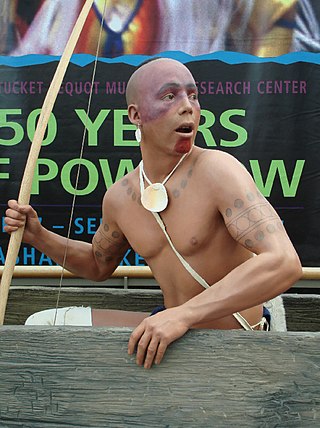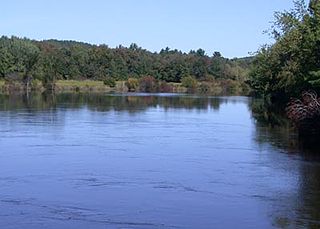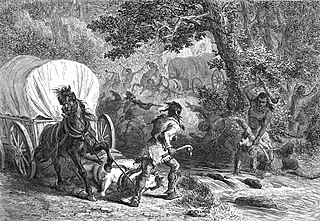
The Pequot are a Native American people of Connecticut. The modern Pequot are members of the federally recognized Mashantucket Pequot Tribe, four other state-recognized groups in Connecticut including the Eastern Pequot Tribal Nation, or the Brothertown Indians of Wisconsin. They historically spoke Pequot, a dialect of the Mohegan-Pequot language, which became extinct by the early 20th century. Some tribal members are undertaking revival efforts.

East Hartford is a town in the Capitol Planning Region, Connecticut, United States. The population was 51,045 at the 2020 census. The town is located on the east bank of the Connecticut River, directly across from Hartford, Connecticut. It is home to aerospace manufacturer Pratt & Whitney. It is also home to Pratt & Whitney Stadium at Rentschler Field, a stadium used mainly for soccer and football with a capacity of 40,000 people.

King Philip's War was an armed conflict in 1675–1676 between a group of indigenous peoples of the Northeastern Woodlands and the English New England Colonies and their indigenous allies. The war is named for Metacomet, the Pokanoket chief and sachem of the Wampanoag who adopted the English name Philip because of the friendly relations between his father Massasoit and the Plymouth Colony. The war continued in the most northern reaches of New England until the signing of the Treaty of Casco Bay on April 12, 1678.
Uncasville is a village in the town of Montville, Connecticut, United States. It is located in southeastern Montville, at the mouth of the Oxoboxo River where it flows into the Thames River. The name is now applied more generally to all of the east end of Montville, which is the area served by the Uncasville ZIP Code.

Miantonomoh, also spelled Miantonomo, Miantonomah or Miantonomi, was a chief of the Narragansett people of New England Indians.

Uncas was a sachem of the Mohegans who made the Mohegans the leading regional Indian tribe in lower Connecticut, through his alliance with the New England colonists against other Indian tribes.

The Pequot War was an armed conflict that took place in 1636 and ended in 1638 in New England, between the Pequot tribe and an alliance of the colonists from the Massachusetts Bay, Plymouth, and Saybrook colonies and their allies from the Narragansett and Mohegan tribes. The war concluded with the decisive defeat of the Pequot. At the end, about 700 Pequots had been killed or taken into captivity. Hundreds of prisoners were sold into slavery to colonists in Bermuda or the West Indies; other survivors were dispersed as captives to the victorious tribes.

The Algonquian are one of the most populous and widespread North American native language groups. They historically were prominent along the Atlantic Coast and in the interior regions along Saint Lawrence River and around the Great Lakes. This grouping consists of the peoples who speak Algonquian languages.
Sassacus was a Pequot sachem who was born near present-day Groton, Connecticut. He became grand sachem after his father, Tatobem, was killed in 1632. The Mohegans led by sachem Uncas rebelled against domination by the Pequots. Sassacus and the Pequots were defeated by English colonists allied with the Narragansett and Mohegans in the Pequot War.

The Pocomtuc were a Native American tribe historically inhabiting western areas of Massachusetts.
The Mohegan are an Algonquian Native American tribe historically based in present-day Connecticut. Today the majority of the people are associated with the Mohegan Indian Tribe, a federally recognized tribe living on a reservation in the eastern upper Thames River valley of south-central Connecticut. It is one of two federally recognized tribes in the state, the other being the Mashantucket Pequot, whose reservation is in Ledyard, Connecticut. There are also three state-recognized tribes: the Schaghticoke, Paugusett, and Eastern Pequot.

The Nashaway were a tribe of Algonquian Indians inhabiting the upstream portions of the Nashua River valley in what is now the northern half of Worcester County, Massachusetts, mainly in the vicinity of Sterling, Lancaster and other towns near Mount Wachusett, as well as southern New Hampshire. The meaning of Nashaway is "river with a pebbled bottom".
The Tunxis were a group of Quiripi speaking Connecticut Native Americans that is known to history mainly through their interactions with English settlers in New England. Broadly speaking, their location makes them one of the Eastern Algonquian-speaking peoples of Northeastern North America, whose languages shared a common root. More locally they were one of a number of Native communities in the lower Connecticut River Valley who shared common cultural traits.

The Battle of Bloody Brook was fought on September 28, 1675 between an indigenous war party primarily composed of Pocumtuc warriors and other local indigenous people from the central Connecticut River valley, and the English colonial militia of the New England Confederation and their Mohegan allies during King Philip's War.

The Mohegan Tribe is a federally recognized tribe and sovereign tribal nation of the Mohegan people. Their reservation is the Mohegan Indian Reservation, located on the Thames River in Uncasville, Connecticut.

The Hammonasset people were a historical Indigenous people of the Northeastern Woodlands whose territory was along the west bank of the Connecticut River to the Hammonasset River in Connecticut.
The Wangunk or Wongunk were an Indigenous people from central Connecticut. They had three major settlements in the areas of the present-day towns of Portland, Middletown, and Wethersfield. They also used lands in other parts of what were later organized by English settlers as Middlesex and Hartford counties. Some sources call the Wangunk the Mattabessett, or Mattabesch, but Wangunk is the name used by scholars and by contemporary Wangunk descendants.
Massachusett Pidgin or Massachusett Jargon was a contact pidgin or auxiliary language derived from the Massachusett language attested in the earliest colonial records up until the mid-eighteenth century. Little is known about the language, but it shared a much simplified grammatical system, with many features similar to the better attested Delaware Jargon spoken in the nearby Hudson and Delaware watersheds. It was mutually intelligible with the other Southern New England Algonquian languages.










